Recently, I attended guitar virtuoso Jack Thammarat’s workshop in Kuala Lumpur, Malaysia. I first discovered Jack Thammarat’s music via his YouTube videos and later on through his work on Jam Track Central. On YouTube, I particularly like his songs Tokyo Trip and Never Again. Jack’s playing is a mix of his influences from Eric Johnson to Andy Timmons. I’ve also been fascinated with his interest in jazz as such as his take on Charlie Parker’s Donna Lee and a recent II-V-I practice video he posted on Facebook.
The workshop I attended was very special to me because when I had the chance to ask Jack questions and jam with him. In addition to answering my questions, he also mentioned that he knows me and has watched many of my videos on YouTube before. I was taken by surprise and very flattered! Later on, during the jam session portion of the workshop an audience member requested for me and Jack to jam. I obliged and felt both nervous and excited! We discussed what song to jam and decided on a C minor blues backing track. It was an awesome experience!
Nothing beats actually being at the workshop. But, I wanted to share some of the most insightful things I learned from the session. Please bear in mind that I’m paraphrasing these tips from my own notes and memory of the workshop. I apologise if there are any mistakes! I hope this captures the essence of what I learned. If you ever get a chance to attend a Jack Thammarat workshop, clinic or meet and greet – go for it. It’s worth it.
Here are 10 of the important things I learned from the workshop:
1. Follow your ear
I asked Jack a question about how he develops long flowing lines in his improvisation. He answered that he still practices improvisation every day and he feels he is not a good improviser yet.
For him, there is a difference between: jamming or improvising and practicing. When he practices, he tries to know everything – the scales and the patterns. When he improvises he tries to forget everything and follow his ears.
2. Play melodies
Jack explains that when he improvises, he focuses on creating melodies. He started with an a D minor pentatonic scale which is the main scale he uses for the song Cry For You. According to Jack, he avoids using sequences or patterns. Instead, he focuses on playing melodies based on the scales.
3. Go back to basics
Jack mentions the importance of bends and vibrato. To him, these are the basics of creating expressive melodies. He proceeded to play a line that used bends to colour the melody!
4. It’s okay to copy
Jack loves the Eric Johnson clean guitar tone so he copied the chorus and tape echo sound that Eric Johnson uses as the basis of his own clean sound. For his overdriven sound, he copied the drive tone from Andy Timmons. To me, this is an interesting perspective as some players are against copying a player’s signature sound. However, hearing Jack play – the specific combination of what he copies actually creates a composite sound that makes a “Jack Thammarat” sound.
Jack believes that everyone has a unique character and no matter how much you copy you will not sound exactly like your influences.
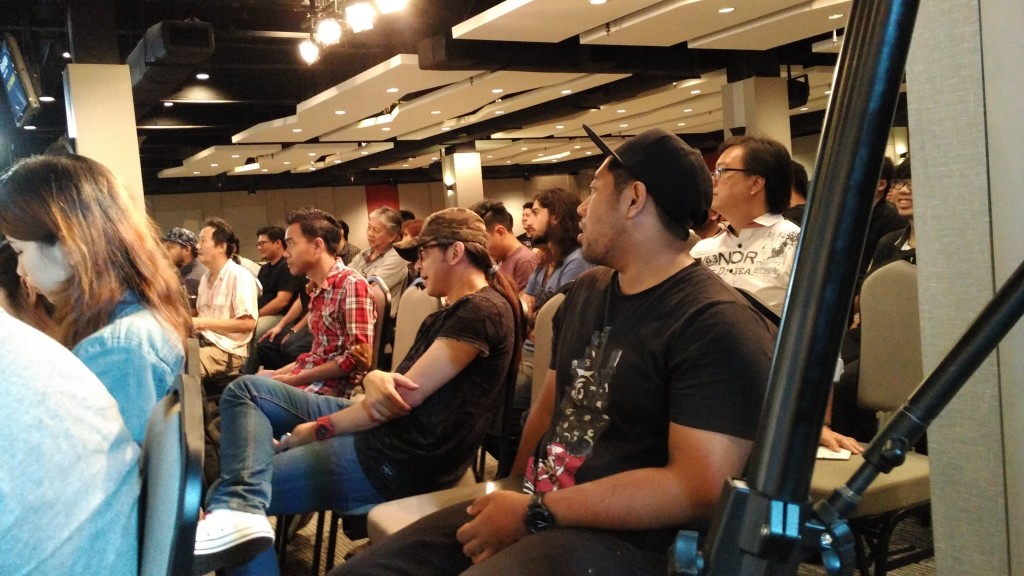
5. Compose your own songs
Jack finds that composing your own song it the most difficult part of being a musician. He feels that to build a song around technique is difficult.
For one of his songs, he started by playing the acoustic guitar strumming part first and then jammed until he heard a melody in his head. He started with a very simple idea and then recorded the guitars, programmed the drums and played the bass.
By composing your own songs, you can develop your own personal style.
6. Finish what you started
The hardest part about composing is finishing your songs. When you’re stuck writing a song halfway, Jack recommends forgetting everything and focus on following your ears. Finish the songs you write!
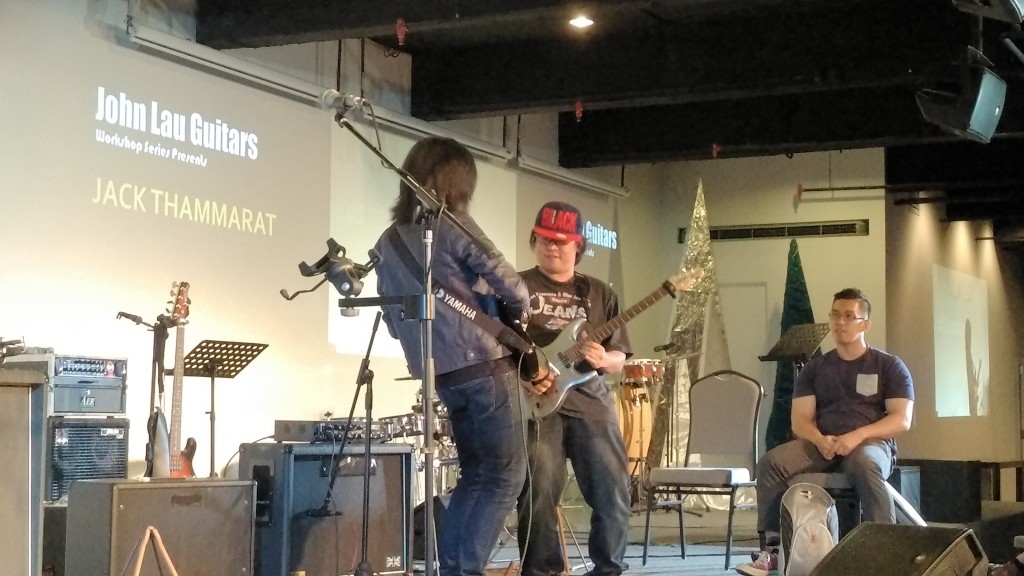
7. Develop your ears
To develop his ears, he went to guitar school and he learned about scales and chords. When he studied with his teacher, he practiced a lot of scales and arpeggios. To demonstrate, he played C Major 7 arpeggios all across the fretboard in different positions. Then, he played it again but sang each note as he played it. He said to practice singing each note until it’s perfect. After doing this exercise for C Major 7 he did the same exercise for every diatonic chord 7th chord in the key of C Major.
C Maj7 Dmin7 Emin7 FMaj7 G7 Amin7 Bmin7(b5)
If he doesn’t hear something, he doesn’t want to play it. Even when playing fast lines, he would sing the lines he plays when he practices.
8. Feel every note that you play
Jack emphasized that you have to feel every note that you play. I could really feel this when I had the opportunity to jam with Jack on stage. I could sense that he was listening very intently and playing every note with purpose.
9. Use tension and release when learning to play “outside”
Jack is still practicing the altered scale. To him, it’s the same as him practicing an A minor pentatonic scale. For a C7(b9) to FMaj7 progression, he used a C#dim7 arpeggio resolving to FMaj7. For some people, they might play Bb minor pentatonic over Amin7 chord. For Jack this sounds okay but it’s not good. For him, to play outside you have to know what is the function for each note relative to the chord.
10. Record your playing
Jack says you have to play everyday and record yourself everyday. Listen to yourself and find what you like about your playing and what you hate about your playing. If you keep playing something you don’t like and if you continue playing it, you are programming yourself to play the things you don’t like.
At the moment, he is practicing a lot of jazz such as II-V-I progressions because he wants to add some jazz chords in his music. He hopes to finish his upcoming first CD soon.
The organiser John Lau then suggested Jack to collaborate with me. It was at this point when Jack said he has watched many of my videos on YouTube before. I was very happy to hear this and hope we do get to collaborate in the future! =)
GUITAR TECHNIQUE PRACTICE TIPS FROM JACK:
[On Soloing]
When soloing over chords that are in different keys, he practices on each chord by playing the respective scales or modes. You have to know the fingering for each scale and then you create lines from the scales.
[Legato playing]
When practicing legato technique, you should make sure each note has the same volume. He also demonstrated all the various combinations for left hand legato fingering.
- 1 and 2
- 1 and 3
- 1 and 4
- 2 and 3
- 2 and 4
- 3 and 4
He practices legato trills for 5-minutes at a time. For him, this is the best way to train your muscle. He recalls an entire year when he had to rest his right hand after he hurt it. However, he used that opportunity to develop his left hand legato technique for a year.
[Picking]
After recovering from his injury, he practiced picking one note as fast as he can. The important thing was to do this without any tension and to be completely relaxed. He also recommends practicing string skipping as he feels this is the most difficult aspect of alternate picking. For him, you have to feel the same when you pick a single string or on multiple strings. Everyone is different so you have to find your best technique and improve on that.
In order to train your picking, he recommends practicing picking a single note without any tension for 5 minutes.
[Bonus anecdotes from John Lau]
As I was writing this blog post, I learned more about Jack from John Lau who organised the event. According to John, after taking Jack out for dinner (on Friday after he arrived), he wanted to go back to his hotel. John and his team thought that Jack was tired but he wasn’t. Jack actually wanted to fulfil his minimum 6 hours of daily guitar practice! On Sunday as they were headed to airport, Jack took out his guitar in the backseat and started practicing.

According to John, Jack also wanted to jam with others, regardless of skill level. John asked whether he’d like for John to filter them but Jack said there was no need to filter, anyone could jam with him!
—-
Hope you found this blog post helpful. Please share this post if you think others might enjoy it!
Thanks to John Lau Guitars for inviting me and my students to this awesome workshop.
Now, I’d love to hear from you.
Have you attended a Jack Thammarat workshop before?
Did you learn something from Jack’s songs?
Leave your answer in the comments below. Remember to share as much detail as possible so that we can all learn from one another. Your insight may help another guitarist someone from across the world.
Thank you for reading and for hanging out here. Be back again soon!
Best wishes,
Az
Wanna read more? Check out 10 Things I Learned From The Guthrie Govan Kuala Lumpur Workshop
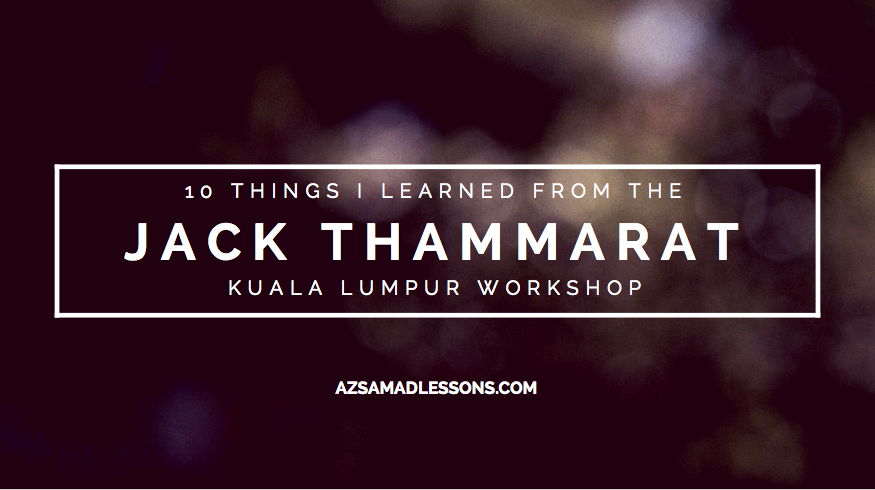
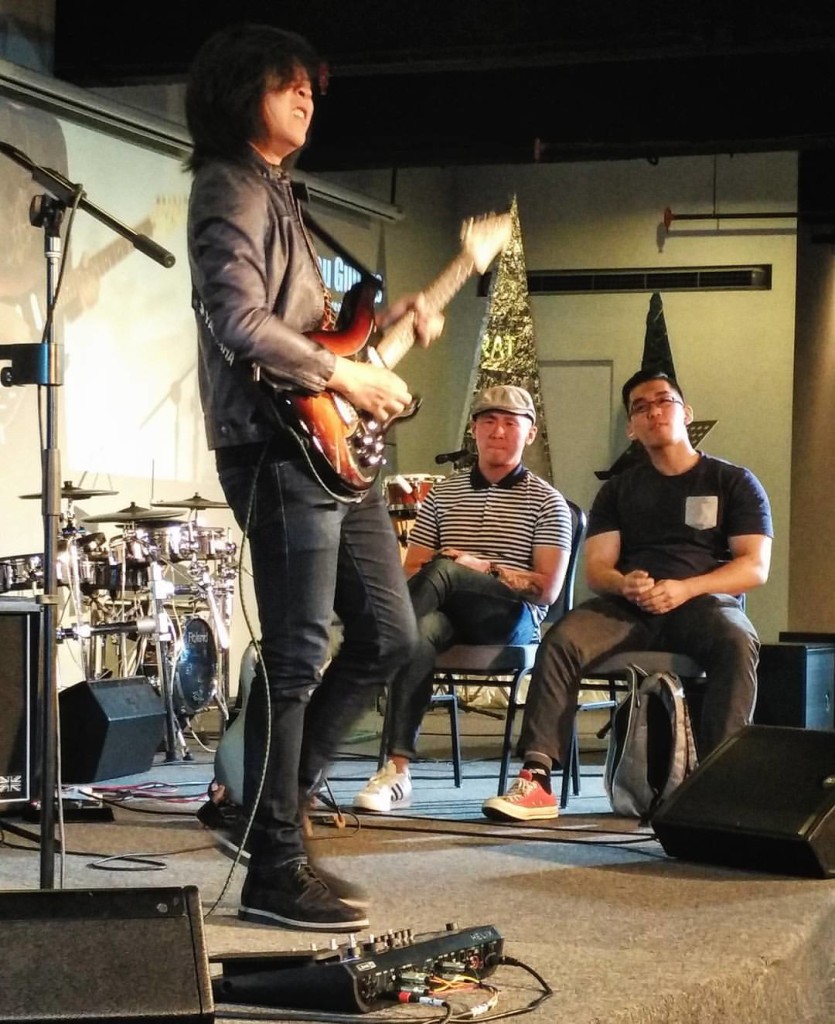
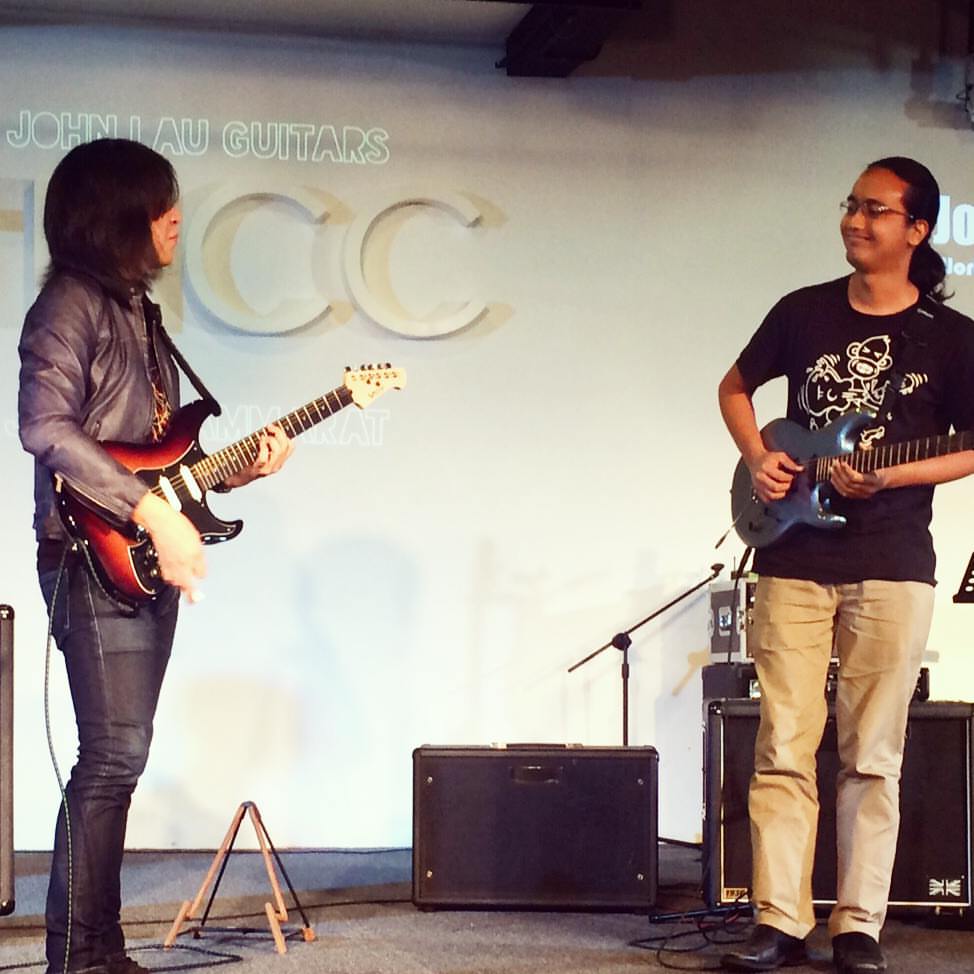


a great post indeed… thank you for summarizing the whole points from jack. love the point number 8 and 10…. that was when he explained his answers for my questions. just what i needed to improve further.
Hello Muhammad Tamin Faruq!
Thanks for reading the post & taking time to comment! Glad you asked those questions, I’m sure it was helpful to a lot of people in the audience. =)
Best wishes,
Az
Thanks, for this great and informative blog .. learned something from the Master .. .. I’m from the Philippines and it’s been awhile seeing Jack in You Tube and .. i have to say he’s far much better than American Players. ..by the way .. what string gauge does Jack uses?.
Hi Roldan, thanks for reading – glad you learned something from Jack – it was a great workshop and he’s a super cool guy. I don’t know actually what string gauge Jack uses. I recommend actually asking him directly on his FB page – he does answer questions there! Thanks again. =)
Thanks for your post! You uncovered some details which can be heard in Jack’s playing, but you only realize it after you read this article!
I tried to sing every note I improvise before, but wasn’t strict about it. Now I will follow this tip 😉
Great to hear that! Thanks for taking time to comment, I’m happy the post was helpful to you! 🙂